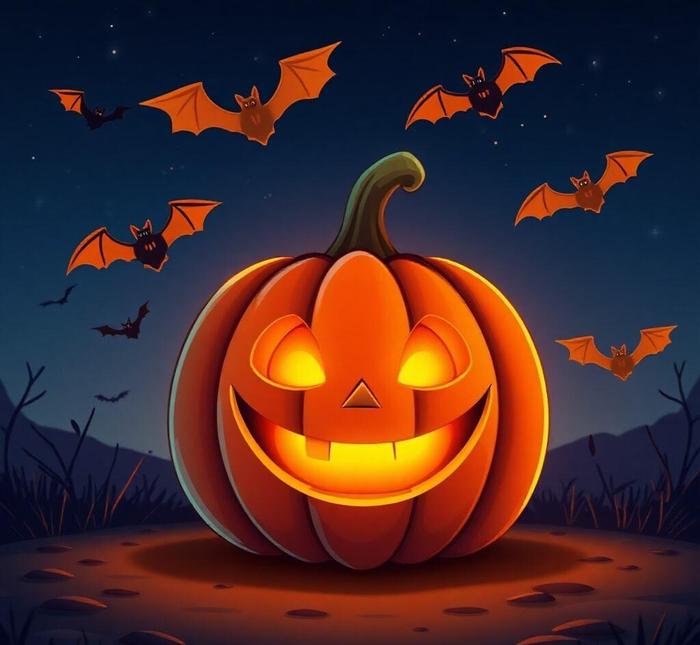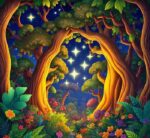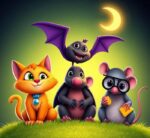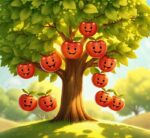- You are here:
- Home »
- words
- » Halloween Words That Start With R [LIST]

Halloween Words That Start With R [LIST]
Halloween is a time of spooky celebrations, eerie decorations, and playful creativity. From chilling costumes to haunting tales, the holiday is rich with words that conjure up its magical and mysterious spirit. Among these, many intriguing Halloween words begin with the letter “R”, bringing to mind images of restless spirits, ravens perched ominously, and rituals that echo through the ages. This collection of ‘R’ words not only embodies the essence of Halloween but also inspires themed activities, writing, and games that make the season even more enjoyable.
Whether you’re brainstorming for a Halloween-themed crossword puzzle, crafting a spine-tingling story, or simply looking to expand your vocabulary, this list of Halloween words starting with ‘R’ is sure to captivate your imagination. Each word holds its own unique connection to the eerie, magical, and sometimes whimsical aspects of the holiday. Dive into this spirited selection and let the ‘R’ words add a touch of enchantment to your Halloween festivities.
Halloween Words That Start With R
1. Reaper
The Reaper is a symbolic figure often associated with death and the afterlife. In folklore and Halloween traditions, the Reaper is usually portrayed as a shadowy figure dressed in dark robes and carrying a large scythe. It is often used in spooky decorations, haunted house themes, and scary costumes.
Examples
- The Grim Reaper is often depicted as a skeletal figure in a hooded cloak carrying a scythe.
- In many cultures, the reaper symbolizes death, and is often seen as an ominous figure during Halloween.
2. Raven
Ravens are large black birds often linked with mystery and the supernatural. In Halloween culture, they are frequently seen as omens or symbols of death and the unknown. Their eerie call and dark feathers make them a staple in spooky decorations and Gothic stories.
Examples
- A raven is a common motif in Halloween imagery, known for its dark, ominous presence.
- In literature, ravens are often associated with mystery and foreboding, such as in Edgar Allan Poe’s poem, ‘The Raven.’
3. Restless
Restless refers to the idea of spirits or entities that cannot find peace, often depicted as wandering or haunting the living. During Halloween, restless spirits are a common theme in stories and hauntings, symbolizing unsettled souls searching for closure or revenge.
Examples
- The restless spirits of the departed are said to wander on Halloween night.
- After the Halloween seance, many reported feeling the presence of restless souls still trapped between worlds.
4. Ritual
A ritual is a series of actions or behaviors performed in a specific order, often for spiritual or magical purposes. On Halloween, rituals may involve offerings, prayers, or spells to invoke supernatural forces, make contact with the dead, or ensure a good harvest.
Examples
- Halloween rituals often include lighting candles, telling ghost stories, and performing divinations.
- Witches and warlocks are said to perform dark rituals to summon spirits during the full moon of Halloween night.
5. Rogue
A rogue refers to an individual or entity that operates outside of normal rules or traditions, often in a rebellious or unpredictable manner. In Halloween lore, rogue characters such as vampires, werewolves, and witches may reject their traditional roles or alliances, making them more dangerous and unpredictable.
Examples
- The rogue vampire was a lone creature, not bound by any coven, who stalked the streets on Halloween night.
- In the horror movie, the rogue werewolf terrorized the town during the full moon.
6. Rancid
Rancid describes a foul, decaying smell, often associated with rotting food, particularly meat or organic matter. In Halloween settings, rancid smells are used in haunted houses or horror films to evoke feelings of disgust and horror.
Examples
- The rancid smell of rotting pumpkins filled the air after weeks of Halloween festivities.
- Rancid meat and foul odors are often used in haunted houses to create a disgusting, unsettling atmosphere.
7. Resurrect
To resurrect means to bring something back to life. In Halloween traditions, resurrection is commonly associated with the return of the dead, often in the form of zombies, ghosts, or spirits. This theme is prevalent in horror films and folklore where characters return from the grave for revenge or to haunt the living.
Examples
- Zombies are often depicted as the resurrected dead, returning to life to seek out the living.
- During Halloween, some cultures celebrate the resurrection of spirits or ancestors in their rituals.
8. Ritualistic
Ritualistic refers to actions that are carried out in accordance with a set pattern, often with spiritual or supernatural significance. In Halloween lore, ritualistic acts are performed to summon spirits, cast spells, or honor the dead, commonly seen in witchcraft and occult practices.
Examples
- The ritualistic sacrifices in the ancient Halloween ceremonies were said to appease the gods of the underworld.
- Witches performed ritualistic acts to invoke supernatural forces during Halloween night.
9. Ravaged
Ravaged refers to something that has been severely damaged or destroyed. In Halloween contexts, ravaged places or people often appear as the result of supernatural events, curses, or attacks by monsters, ghosts, or other sinister forces.
Examples
- The haunted house was ravaged by years of neglect, with cobwebs in every corner and broken windows.
- The village was ravaged by a ghostly plague on Halloween night, with only a few survivors left.
10. Revenge
Revenge is the act of seeking retribution for a wrong that has been done, often through violence or manipulation. Halloween stories are filled with vengeful spirits, ghosts, and monsters who return from the afterlife to exact their revenge on the living.
Examples
- The ghost sought revenge on those who wronged him in life, terrorizing the town on Halloween night.
- A theme of revenge often runs through many Halloween stories, where characters return to settle old scores.
11. Rituals
Rituals are sacred or ceremonial acts that are performed according to tradition or belief. Halloween rituals often include practices such as carving jack-o’-lanterns, wearing costumes, and performing divinations to honor the dead or ward off evil spirits.
Examples
- Some Halloween rituals involve carving pumpkins or making offerings to ward off evil spirits.
- The witches performed their ancient rituals around a bonfire during Halloween.
12. Revolt
Revolt refers to an uprising or rebellion against an established power or authority. In Halloween horror themes, revolting characters such as zombies, ghouls, or spirits rebel against the living, often seeking revenge or causing terror.
Examples
- The zombies revolted against their creators, wreaking havoc across the town on Halloween night.
- In the story, the ghostly spirits revolted, demanding the living be punished for their past sins.
Historical Context

Halloween, a holiday widely celebrated on October 31st, is rich with history, folklore, and symbolism. It has its roots in ancient traditions such as the Celtic festival of Samhain, which marked the end of the harvest season and the beginning of winter. It was believed that on the night of Samhain, the boundary between the worlds of the living and the dead was blurred, and spirits could pass through into the realm of the living. Over time, these customs were merged with Roman and Christian influences, eventually evolving into the Halloween we know today.
Among the words associated with Halloween, those that start with the letter "R" carry a particularly eerie resonance, often referring to figures, creatures, and practices that invoke the supernatural, the spooky, and the macabre. These words—like "ritual," "reaper," "raven," and "revenant"—speak to the themes of death, the afterlife, and the mysterious forces at work during this ghostly holiday. Understanding the historical context of these terms deepens our appreciation for the holiday and the beliefs that shaped it. Many of these words have their origins in ancient cultures, particularly those with strong connections to death and the spirit world, such as the Celts, the Romans, and even early Christian communities.
For instance, "ritual" traces its roots to religious ceremonies and customs, many of which were believed to protect the living from spirits or to honor the dead. In Celtic tradition, rituals were a way of ensuring that the deceased did not return to cause harm. The idea of spirits roaming freely at night—something central to Halloween lore—was thus linked to a long history of ritual practices aimed at warding off unwanted supernatural guests.
Similarly, the "raven," often seen as an omen of death or as a messenger between the realms of the living and the dead, has symbolic significance rooted in various ancient cultures. The bird’s dark feathers and eerie call have contributed to its association with omens and otherworldly powers, cementing its place in Halloween traditions.
Word Origins And Etymology
Exploring the word origins and etymology of Halloween-related terms that begin with "R" reveals fascinating layers of meaning and history. Many of these words come from Old English, Latin, or ancient Celtic, reflecting the deep cultural interweaving that defines Halloween.
-
Ritual – Derived from the Latin word ritus, meaning "a prescribed or customary form," the term "ritual" originally referred to ceremonial acts, especially those performed in a religious or spiritual context. Over time, the word expanded to include any repeated or established practice, especially those designed to connect the human world to the divine or supernatural. Halloween rituals, which include things like carving pumpkins, trick-or-treating, or conducting seances, can be traced to ancient practices that sought to honor the dead and protect the living.
-
Reaper – The term "reaper," especially associated with the Grim Reaper figure in Halloween lore, is rooted in the Old English word reopan, meaning "to reap" or "to harvest." It was commonly used in agricultural contexts to describe someone who harvests crops. However, in the context of Halloween, the reaper came to symbolize death, a figure that harvests human souls as one would crops in the field. The image of the Grim Reaper, often depicted with a skeletal face and scythe, emerged over centuries as a representation of the inevitable passage from life to death.
-
Raven – The raven, with its deep black feathers and eerie calls, has been associated with death and the supernatural for centuries. The word "raven" comes from the Old English hræfn, which has cognates in various Germanic languages, all stemming from Proto-Indo-European roots related to the bird’s dark color. In Norse mythology, ravens were the messengers of Odin, the god of death and war, which helped solidify the bird’s association with the afterlife and the mysteries of death in the Halloween tradition.
-
Revenant – This term comes from the French verb revenir, meaning "to return." A revenant refers to a being, typically a ghost or a zombie-like creature, who has returned from the dead. It originally described the return of a dead person’s spirit in medieval Europe. As Halloween grew in popularity, the term evolved to encompass any ghostly or undead entity, contributing to the chilling atmosphere of the holiday.
-
Resurrection – Although this word is more commonly associated with religious themes, it also plays a role in Halloween traditions. From the Latin resurrectio, meaning "a rising again," resurrection is the concept of coming back to life after death. This idea has been central to numerous Halloween myths and stories, from the returning spirits of the dead to creatures like vampires and zombies who walk among the living.
Common Misconceptions
While Halloween is a time for fun, frights, and folklore, some of the words starting with "R" often carry misconceptions or are misunderstood in modern culture. These misunderstandings can distort the deeper meanings of these terms, which are tied to much older traditions and stories.
-
Ritual – A common misconception surrounding Halloween rituals is that they are primarily focused on "evil" or "dark" magic. While it’s true that some modern Halloween practices, like Ouija boards or attempts to contact spirits, can have sinister undertones, most rituals historically were focused on protection, remembrance, and ensuring a safe transition for souls to the afterlife. Many rituals performed during Halloween were designed to honor ancestors or provide offerings to spirits to prevent them from causing harm.
-
Reaper – The image of the Grim Reaper is often seen as a terrifying figure of death, usually portrayed as an evil, malevolent force. However, in historical contexts, the figure of the reaper wasn’t always feared. In some cultures, death was seen as a necessary part of life and was even viewed with reverence. The Grim Reaper’s scythe, which is often thought of as a tool for harvesting souls, originally symbolized the reaping of crops and the cycle of nature, rather than a predatory force.
-
Raven – The raven’s association with death and bad omens is widely known, especially due to literature like Edgar Allan Poe’s "The Raven." However, not all cultures viewed the raven negatively. In Norse mythology, ravens were revered as symbols of wisdom and knowledge, serving as messengers for Odin, the god of wisdom and death. In Celtic tradition, ravens were often seen as protective spirits.
-
Revenant – While a revenant is often depicted as a bloodthirsty zombie or vengeful spirit, the term originally referred to a person who returned from the dead—sometimes a ghostly figure who was not inherently malicious. In many folklore traditions, revenants were more likely to return for specific unfinished business, rather than to wreak havoc. This nuanced view of revenants shows that they weren’t universally evil, but were seen more as troubled souls.
Conclusion
Halloween words starting with the letter "R" offer a rich tapestry of history, mythology, and misinterpretations. Terms like "ritual," "reaper," "raven," and "revenant" carry with them not just spooky connotations, but also centuries-old meanings and cultural significance. From the rituals that sought to honor the dead, to the grim figure of the reaper who symbolized the inevitability of death, these words provide a glimpse into the traditions and beliefs that have shaped Halloween into the celebration we recognize today. While some misconceptions may overshadow the deeper meanings of these words, taking the time to explore their true origins can enhance our understanding and appreciation of Halloween. After all, at its heart, Halloween is a time to reflect on life, death, and the mysterious spaces in between.








